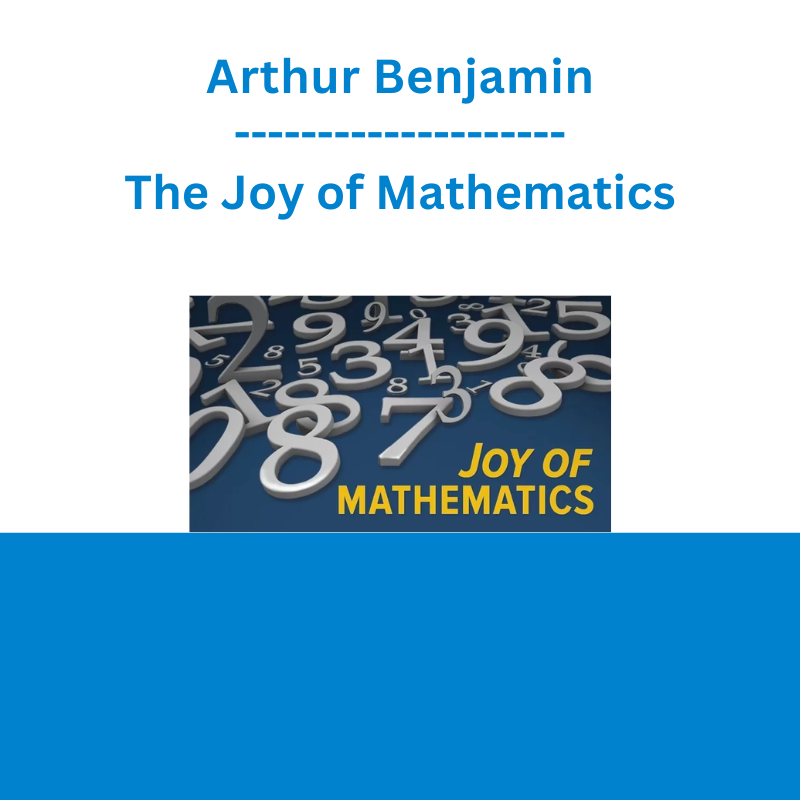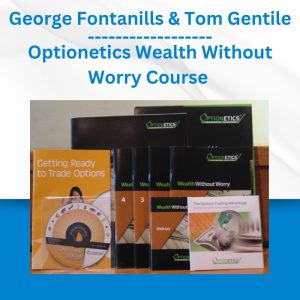*** Proof of Product ***
Exploring the Essential Features of “Arthur Benjamin – The Joy of Mathematics”
The Joy of Mathematics
Revel in the sheer joy of mathematics with this fun and exciting course, taught by an award-winning mathematician, that explores a wide range of mathematical ideas.
LESSON
Trailer
01:The Joy of Math-The Big Picture
Professor Benjamin introduces the ABCs of math appreciation: The field can be loved for its applications, its beauty and structure, and its certainty. Most of all, mathematics is a source of endless delight through creative play with numbers….
31 min
02:The Joy of Numbers
How do you add all the numbers from 1 to 100-instantly? What makes a square number square and a triangular number triangular? Why do the rules of arithmetic really work, and how do you calculate in bases other than 10?
29 min
03:The Joy of Primes
A number is prime if it is evenly divisible by only itself and one: for example, 2, 3, 5, 7, 11. Professor Benjamin proves that there are an infinite number of primes and shows how they are the building blocks of our number system.
30 min
04:The Joy of Counting
Combinatorics is the study of counting questions such as: How many outfits are possible if you own 8 shirts, 5 pairs of pants, and 10 ties? A trickier question: How many ways are there to arrange 10 books on a shelf? Combinatorics can also be used to analyze numbering systems, such as ZIP Codes or license plates, as well as games of chance….
28 min
05:The Joy of Fibonacci Numbers
The Fibonacci numbers follow the simple pattern 1, 1, 2, 3, 5, 8, etc., in which each number is the sum of the two preceding numbers. Fibonacci numbers have many beautiful and unexpected properties, and show up in nature, art, and poetry….
30 min
06:The Joy of Algebra
Arguably the most important area of mathematics, algebra introduces the powerful idea of using an abstract variable to represent an unknown quantity. This lecture demonstrates algebra’s golden rule: Do unto one side of an equation as you do unto the other.
31 min
07:The Joy of Higher Algebra
This lecture shows how to solve quadratic (second-degree) equations from the technique of completing the square and the quadratic formula. The quadratic formula reveals the connection between Fibonacci numbers and the golden ratio….
31 min
08:The Joy of Algebra Made Visual
Algebra can be used to solve geometrical problems, such as finding where two lines cross. The technique is useful in real-life problems, for example, in choosing a telephone plan. Graphs help us better understand everything from lines to equations with negative or fractional exponents.
32 min
09:The Joy of 9
Adding the digits of a multiple of 9 always gives a multiple of 9. For example: 9 x 4 = 36, and 3 + 6 = 9. In modular arithmetic, this property allows checking answers by “casting out nines.” A related trick: mentally computing the day of the week for any date in history….
32 min
10:The Joy of Proofs
Professor Benjamin begins his discussion of mathematical proofs with intuitive cases like “even plus even is even” and “odd times odd is odd.” He builds to more complex proofs by existence and induction, and ends with a checkerboard challenge….
31 min
11:The Joy of Geometry
Geometry is based on a handful of definitions and axioms involving points, lines, and angles. These lead to important conclusions about the properties of polygons. This lecture uses geometric reasoning to derive the Pythagorean theorem and other interesting results….
31 min
12:The Joy of Pi
Pi is the ratio of the circumference of a circle to its diameter. It starts 3.14 and continues in an infinite nonrepeating sequence. Professor Benjamin shows how to learn the first hundred digits of this celebrated number, making it look as easy as pie.
31 min
13:The Joy of Trigonometry
Trigonometry deals with the sides and angles of triangles. This lecture defines sine, cosine, and tangent, along with their reciprocals, the cosecant, secant, and cotangent. Extending these definitions to the unit circle allows a handy measure of angle: the radian….
32 min
14:The Joy of the Imaginary Number i
Could the apparently nonsensical number the square root of -1 be of any use? Very much so, as this lecture shows. Such imaginary and complex numbers play an indispensable role in physics and other fields, and are easier to understand than they appear….
31 min
15:The Joy of the Number e
Another indispensable number to learn is e = 2.71828 … Defined as the base of the natural logarithm, e plays a central role in calculus, and it arises naturally in many spheres of mathematics, including calculations of compound interest….
30 min
16:The Joy of Infinity
What is the meaning of infinity? Are some infinite sets “more” infinite than others? Could there possibly be an infinite number of levels of infinity? This lecture explores some of the strange ideas associated with mathematical infinity.
30 min
17:The Joy of Infinite Series
Starting with the analysis of the proposition 0.999999999 … = 1, this lecture explores what it means to add up an infinite series of numbers. Some infinite series converge on a definite value, while others grow arbitrarily large.
31 min
18:The Joy of Differential Calculus
Calculus is the mathematics of change, and answers questions such as: How fast is a function growing? This lecture introduces the concepts of limits and derivatives, which allow the slope of a curve to be measured at any point….
32 min
19:The Joy of Approximating with Calculus
Exploiting the idea of the derivative, we can approximate just about any function using simple polynomials. This lecture also shows why a formula sometimes known as “God’s equation” (involving e, i, p, 1, and 0) is true, and how to calculate square roots in your head….
31 min
20:The Joy of Integral Calculus
Geometry and trigonometry are used to determine the areas of simple figures such as triangles and circles. But how are more complex shapes measured? Calculus comes to the rescue with a technique called integration, which adds the simple areas of many tiny quantities….
32 min
21:The Joy of Pascal’s Triangle
A geometric arrangement of binomial coefficients called Pascal’s triangle is a treasure trove of beautiful number patterns. It even provides an answer to the song “The Twelve Days of Christmas”: Exactly how many gifts did my true love give to me?…
32 min
22:The Joy of Probability
Mathematics can draw detailed inferences about random events. This lecture covers major concepts in probability, such as the law of large numbers, the central limit theorem, and how to measure variance….
30 min
23:The Joy of Mathematical Games
This lecture applies the law of total probability and other concepts from the course to predict the long-term losses to be expected from playing games such as roulette and craps and understand what is known as the “Gambler’s Ruin Problem.”
31 min
24:The Joy of Mathematical Magic
Closing the course with a magician’s flair, Professor Benjamin shows a trick for producing anyone’s phone number, how to create a magic square based on your birthday, how to play “mathematical survivor,” a technique for computing cube roots in your head, and a card trick to ponder.
31 min
DETAILS
Overview
Humans have been having fun and games with mathematics for thousands of years. Along the way, they’ve discovered the amazing utility of this field&;amp;-in science, engineering, finance, games of chance, and many other aspects of life. This course of 24 half-hour lectures celebrates the sheer joy of math, taught by a mathematician who is literally a magician with numbers. Professor Arthur T. Benjamin shows how everything in mathematics is connected&;amp;-how the beautiful and often imposing edifice that has given us algebra, geometry, trigonometry, calculus, probability, and so much else is based on nothing more than fooling around with numbers.
About
Arthur T. Benjamin
As a professor, I have always wanted to bring math to the masses. The Great Courses has helped make that dream come true.
Dr. Arthur T. Benjamin is Professor of Mathematics at Harvey Mudd College. He earned a Ph.D. in Mathematical Sciences from Johns Hopkins University in 1989. Professor Benjamin’s teaching has been honored repeatedly by the Mathematical Association of America (MAA). In 2000, he received the MAA Deborah and Franklin Tepper Haimo National Award for Distinguished College or University Teaching of Mathematics. The MAA also named Professor Benjamin the 2006-2008 George Pólya Lecturer. In 2012, Princeton Review profiled him in The Best 300 Professors. He is a professional magician, whose techniques are explained in his book Secrets of Mental Math: The Mathemagician’s Guide to Lightning Calculation and Amazing Math Tricks. Professor Benjamin also served for five years as coeditor of Math Horizons magazine. An avid games player, Dr. Benjamin is a past winner of the American Backgammon Tour and has written more than 15 papers on the mathematics of games and puzzles. Professor Benjamin has appeared on dozens of television and radio programs and has been featured in publications, including Scientific American, People, and The New York Times. In 2005, Reader’s Digest called him America’s Best Math Whiz.
REVIEWS
Chantal
Looks like it was “filmed” in the late ’80’s.
would not recommend this course. It looks like something that was dredged up from 1980’s and rebranded as a great course. The video and graphics quality was so bad couldn’t even get through the first course. Would like our money back.
Diggee17
Professor’s clothes are distracting
I bought this course several years ago but I’ve never gotten past first lesson. The
professor ‘s clothing are too distracting. Why does he have on clothes that are 3 sizes too big? If you are going to do a video it should not look like it was filmed in the fifties. I would not use this video to teach kids about math as their are more engaging options online
SusanR
Fantastic Instructor!!
Each mathematical concept is explained simply and easily, making it a true JOY to learn mathematics!!
Please see the full list of alternative group-buy courses available here: https://lunacourse.com/shop/









